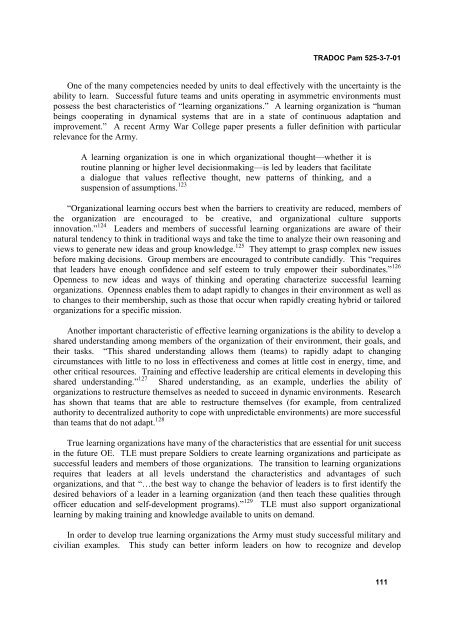TRADOC Pam 525-3-7-01 - TRADOC - U.S. Army
TRADOC Pam 525-3-7-01 - TRADOC - U.S. Army
TRADOC Pam 525-3-7-01 - TRADOC - U.S. Army
- No tags were found...
Create successful ePaper yourself
Turn your PDF publications into a flip-book with our unique Google optimized e-Paper software.
<strong>TRADOC</strong> <strong>Pam</strong> <strong>525</strong>-3-7-<strong>01</strong>One of the many competencies needed by units to deal effectively with the uncertainty is theability to learn. Successful future teams and units operating in asymmetric environments mustpossess the best characteristics of “learning organizations.” A learning organization is “humanbeings cooperating in dynamical systems that are in a state of continuous adaptation andimprovement.” A recent <strong>Army</strong> War College paper presents a fuller definition with particularrelevance for the <strong>Army</strong>.A learning organization is one in which organizational thought—whether it isroutine planning or higher level decisionmaking—is led by leaders that facilitatea dialogue that values reflective thought, new patterns of thinking, and asuspension of assumptions. 123“Organizational learning occurs best when the barriers to creativity are reduced, members ofthe organization are encouraged to be creative, and organizational culture supportsinnovation.” 124 Leaders and members of successful learning organizations are aware of theirnatural tendency to think in traditional ways and take the time to analyze their own reasoning andviews to generate new ideas and group knowledge. 125 They attempt to grasp complex new issuesbefore making decisions. Group members are encouraged to contribute candidly. This “requiresthat leaders have enough confidence and self esteem to truly empower their subordinates.” 126Openness to new ideas and ways of thinking and operating characterize successful learningorganizations. Openness enables them to adapt rapidly to changes in their environment as well asto changes to their membership, such as those that occur when rapidly creating hybrid or tailoredorganizations for a specific mission.Another important characteristic of effective learning organizations is the ability to develop ashared understanding among members of the organization of their environment, their goals, andtheir tasks. “This shared understanding allows them (teams) to rapidly adapt to changingcircumstances with little to no loss in effectiveness and comes at little cost in energy, time, andother critical resources. Training and effective leadership are critical elements in developing thisshared understanding.” 127 Shared understanding, as an example, underlies the ability oforganizations to restructure themselves as needed to succeed in dynamic environments. Researchhas shown that teams that are able to restructure themselves (for example, from centralizedauthority to decentralized authority to cope with unpredictable environments) are more successfulthan teams that do not adapt. 128True learning organizations have many of the characteristics that are essential for unit successin the future OE. TLE must prepare Soldiers to create learning organizations and participate assuccessful leaders and members of those organizations. The transition to learning organizationsrequires that leaders at all levels understand the characteristics and advantages of suchorganizations, and that “…the best way to change the behavior of leaders is to first identify thedesired behaviors of a leader in a learning organization (and then teach these qualities throughofficer education and self-development programs).” 129 TLE must also support organizationallearning by making training and knowledge available to units on demand.In order to develop true learning organizations the <strong>Army</strong> must study successful military andcivilian examples. This study can better inform leaders on how to recognize and develop111



